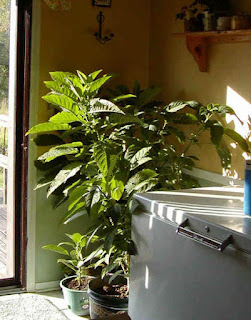Those of you who live in the north, as I do, know the frustration of working with a short growing season. There are so many new and interesting things to grow out there and I would like to grow them all, at least once. Our short growing season, sometimes makes that difficult. I plant seeds early indoors on the windowsill but that is not always enough and there is not a lot of room on my windowsill. I could set up artificial lighting indoors but the cost in electricity would sometimes offset the benefits of growing my own food. A good way to overcome the short season is with a cold frame.

A cold frame is a small greenhouse built into the ground. This takes advantage of the insulating properties of the earth itself. The only glass you need is the top. I built mine using a glass patio door, but it can also be done with smaller windows. Double paned is better insulation against the winter cold but single paned will also work, especially if you are only using it spring and autumn and do not intend to overwinter plants inside a heated cold frame. Some gardeners put heating cables inside the cold frame in order to grow greens in there all winter. Other gardeners heat it with a manure and hay mix, taking advantage of the chemical reaction that causes heat. I only use mine for starting seedlings early in the spring and hardening off what I have started.
 Before I had a cold frame I had many, many seedlings in trays that I brought into the house each and every night. I then brought them back out into the sun the next morning, in and out, in and out - it gets quite tedius. The cold frame made the entire hardening off process much easier. I just put all my seedlings into the cold frame as soon as it was barely warm enough and closed the lid. I did have to wash the lid first for the sun to get through. It was covered with little muddy racoon prints, among other things.
Before I had a cold frame I had many, many seedlings in trays that I brought into the house each and every night. I then brought them back out into the sun the next morning, in and out, in and out - it gets quite tedius. The cold frame made the entire hardening off process much easier. I just put all my seedlings into the cold frame as soon as it was barely warm enough and closed the lid. I did have to wash the lid first for the sun to get through. It was covered with little muddy racoon prints, among other things. I lined my hole in the ground with 2" wood. I also cut the wood so the back would be 6" higher than the front. This allows the sun to reach more of the seedlings and gives me a bit more height to play with. I put shelves in the cold frame to raise the baby seedlings up to the window. I lowered these as the plants grew taller. It is important to keep the leaves of your seedlings away from the glass or they will rot on the glass and block the light.
I lined my hole in the ground with 2" wood. I also cut the wood so the back would be 6" higher than the front. This allows the sun to reach more of the seedlings and gives me a bit more height to play with. I put shelves in the cold frame to raise the baby seedlings up to the window. I lowered these as the plants grew taller. It is important to keep the leaves of your seedlings away from the glass or they will rot on the glass and block the light.  As spring goes on and the weather warms up, you may need to open the lid a bit during the hottest part of the spring day. The sun shining directly into the cold frame can raise the heat to a temperature that may cook your tender seedlings under the glass. This also helps to harden them off as they grow thicker stems to adjust to the breeze.
As spring goes on and the weather warms up, you may need to open the lid a bit during the hottest part of the spring day. The sun shining directly into the cold frame can raise the heat to a temperature that may cook your tender seedlings under the glass. This also helps to harden them off as they grow thicker stems to adjust to the breeze.Glass patio doors are not hard to pick up for very little cost. I got mine free at the side of the road. I also managed to pick up four more new and single paned glass patio doors this past summer. All for for free!! People are always rebuilding their homes and replacing old windows and doors. Keep your eyes open as you drive around and let all of your friends know what you are looking for.
I have visions of a long line of cold frames along the edge of the garden. I have the doors and wood to build them, I just don't have the time! It is an age old problem and a really nice dream!





































